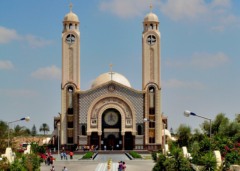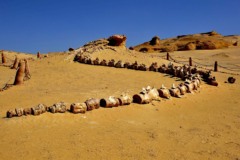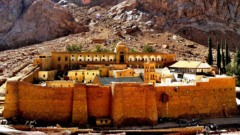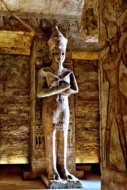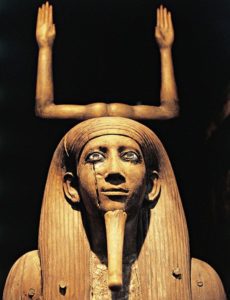The Philae Temple Complex is one of the most interesting old places to visit in Egypt. It used to be on Philae Island, which was a holy place for the Isis cult and has been there for thousands of years. The 30th-dynasty pharaoh Nectanebo I started building the temple complex we see today. The Greek, Roman, and Byzantine rulers who came after him added to it. After the Aswan Low Dam was built at the beginning of the 20th century, water got into part of the complex.
Philae Temple Egypt
Later, plans for a second dam led UNESCO to start a project to save the temples by moving them to higher ground on the nearby island of Agilkia. Tourists are still amazed by the complex today, just as they have been for hundreds of years. Philae Island was once thought to be one of the places where the ancient Egyptian god Osiris was buried. It used to be in a bend in the River Nile. Egyptians and their Nubian neighbors thought it was sacred to his wife, Isis.
Archaeologists have found evidence that temples to Isis have been on the island since at least the 6th century BC. The Temple of Isis is the oldest building that is still standing. It was built during the reign of Nectanebo I, who was king from about 380 BC to 362 BC. He started the last dynasty of pharaohs who were born and raised in Egypt. Ptolemaic and Roman rulers kept adding to the temple complex until the 3rd century AD.
It was a place of pilgrimage for people who followed the cult of Isis for a long time after Christianity came to Egypt. In fact, the temples weren’t shut down or turned over to Christian use until the sixth century AD. This makes the Philae temple complex one of the last places in the country where people went to worship pagan gods. Philae was one of the most popular places for European tourists who were interested in Egyptology during the Victorian era. It is still a highlight of Nile cruises today.
Philae Temple Aswan
When the Aswan Low Dam was built in 1902, it flooded Philae Island and its temple complex for most of the year. The partially submerged ruins could be seen by tourists from a rowboat, and the foundations of the temples were made stronger to help them withstand the damage caused by the annual floods. But river silt stuck to the bricks, and the colors on the temple’s beautiful reliefs were washed away.
When plans for the Aswan High Dam were made public in 1954, it was clear that Philae Island would soon be completely submerged, and its ancient treasures would be lost for good. In 1960, UNESCO started the International Campaign to Save the Monuments of Nubia to try to stop this from happening. The project dug up and wrote down information about hundreds of sites and found thousands of artifacts that would soon be lost to the sea.
It also made plans to move some of the most important temples in the area, such as Abu Simbel, which is near Lake Nasser, and the Philae temple complex. At Philae, a coffer dam was built to keep the river from flooding the monuments while they were being cleaned, measured, and taken apart. The temple and its shrines and sanctuaries were carefully moved brick by brick to the nearby island of Agilkia and rebuilt on higher ground. In the name of authenticity, Agilkia was even landscaped to match the temple’s original setting on Philae Island.
Temple of Isis
Modern tourists come by boat and start their tour at the Kiosk of Nectanebo, which is the oldest part of the Temple of Isis. The First Pylon, a monumental 18-meter-tall gateway with amazing reliefs, stands guard at the entrance to the main temple. Various pharaohs and Ptolemaic kings are credited with making these reliefs. One of the most famous shows Ptolemy XII, Neos Dionysos, killing a group of enemies. Isis, Horus of Edfu, Hathor, and many other Egyptian gods and goddesses also show up.
After passing through the First Pylon, visitors find themselves in the temple forecourt. On either side are colonnades that lead to different rooms, including the Birth House. This interesting building was made for Isis to celebrate the birth of her son Horus. It has reliefs on the walls that show scenes from Horus’s childhood. In the past, pharaohs held ceremonies here to honor the story of Isis (which included their own descent from Horus, thereby legitimizing their divine right to rule).
The entrance to the inner temple’s vestibule is through a second pylon. It has eight beautiful columns, and Coptic crosses carved into the walls show how the temple was changed into a place of Christian worship during the Byzantine era. The sanctuary is past the vestibule. There, granite shrines used to hold a gold statue of Isis and the boat it traveled on. These are now in museums in Paris and Florence.
Other Buildings of Interest
Even though the Temple of Isis is the main attraction, there are a number of other interesting buildings in the complex. The Ptolemaic kings Philometor and Euergetes II built the Temple of Hathor, and the Emperor Augustus added to it later. The reliefs on the Gateway of Hadrian were ordered by the Roman emperors Hadrian, Marcus Aurelius, and Lucius Verus. Trajan’s Kiosk, which was never finished but is still beautiful, was a favorite subject of Victorian painters. There are the remains of a monastery and two Coptic churches among the Christian ruins.
How to Get There
You can get to the Philae temple complex in a number of ways. Most of the cruises that go up and down the Nile between Luxor and Aswan stop at Agilkia Island. A different option is to take a day trip from Aswan to the Philae temple complex and other nearby places of interest like the Unfinished Obelisk and the Aswan High Dam. It is also possible to set up a visit on your own. Just take a taxi from Aswan to the Marina Philae Temple, where boats ready to take people to Agilkia Island are waiting.
Philae Temple Sound and Light Show
The Philae Sound and Light Show is one of the most popular ways to see the complex. This show happens after dark and uses colored lights, laser projections, and audio commentary to bring back the ancient pharaohs and bring the story of Isis, Osiris, and Horus to life in a dramatic way. There are presentations in English, French, German, and Spanish, among other languages. Tour companies offer packages that include entrance fees, river transportation, a guide, and pick-up and drop-off at your hotel.
Philae Temple Ticket Price
Entrance Fees and Hours of Operation: From October to May, you can usually visit between 7 a.m. and 4 p.m. From June to September, between 7 AM and 5 PM. The price for adults is 50 EGP, which is about $3, and the price for students is 25 EGP. If you’re good at bargaining, a boat ride from the mainland to Agilkia Island and back should cost about 10 EGP, but boatmen will usually try to charge more. A ticket to the Sound and Light Show costs $14 per person.

